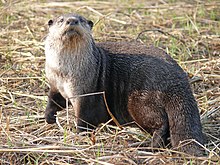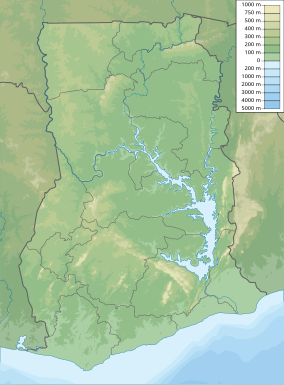Digya National Park
| Digya National Park | |
|---|---|
| Location | Bono East Region of Ghana |
| Coordinates | 7°25′N 0°17′W / 7.417°N 0.283°W |
| Area | 3,743 km² |
| Established | 1971 |
Digya National Park is the second largest national park and the oldest protected area in Ghana. It is located in the Bono East Region.[1]
History
[edit]Digya National Park was created in 1900 as a protected area, the first in Ghana.[2] It was acquired by the government[3] and gazetted as a national park in 1971.[2] When the government acquired the park, there were living settlements in the park, with most of the residents being fishermen and farmers. In 2006, there were 49 settlements and the government of Ghana began evicting settlement residents from the park.[3] In early 2005, a patrol-based system was established in the park to curb illegal activity.[4]
Geography
[edit]Occupying an area of 3,743 km2 (1,445 sq mi), the park is the second largest national park in Ghana. It is in the Bono East region and is bordered on the north, south, and east by Lake Volta.[2] This park is the only wildlife territory in Ghana to border on Lake Volta, the largest man-made body of water in the world.[2][5] Located on a lowland peninsula, it has an undulating terrain.[6] It lies in a transitional zone between forest and savanna.[7]

Wildlife
[edit]The park is home to at least six primate species[5] and elephants belonging to some of the less studied species in Africa. The elephant population in the park is the second largest in Ghana.[8] Antelope species are also found in the park. There are also manatees and African clawless otters in the arms of Lake Volta that extend into Digya National Park. More than 236 species of birds live in the park,[2] which has been designated an Important Bird Area (IBA) by BirdLife International because it supports significant populations of many bird species.[9]
References
[edit]- ^ Bureau, Communications. ""Bono East Officially Created; Techiman Is Capital" – President Akufo-Addo". presidency.gov.gh. Retrieved 2020-08-18.
{{cite web}}:|last=has generic name (help) - ^ a b c d e "Digya National Park". Ghana Wildlife Division. Archived from the original on 23 August 2011. Retrieved 19 August 2011.
- ^ a b Boyefio, Gilbert; Salinas, Eva (11 April 2007). "Digya National Park, residents lives far from normal". GhanaWeb. Archived from the original on 19 September 2011. Retrieved 19 August 2011.
- ^ Jachmann, Hugo (January 2008). "Monitoring law-enforcement performance in nine protected areas in Ghana" (PDF). Biological Conservation. 141 (1). Elsevier: 89–99. doi:10.1016/j.biocon.2007.09.012. Retrieved 19 August 2011.
Previous studies showed that the amount of illegal activity predominantly depends on resource allocation for law enforcement, in terms of staff density, patrol effort and fund- ing (Leader-Williams and Albon, 1988; Leader-Williams et al., 1990; Dublin and Jachmann, 1992; Jachmann and Billiouw, 1997; Jachmann, 1998, 2002)...Early 2005, the same system was established in Kogyae Strict Nature Reserve and in Digya National Park (Fig. 1).
[permanent dead link] - ^ a b "Ghana National Parks". Palace Travel. Archived from the original on 10 January 2012. Retrieved 19 August 2011.
- ^ "Ghana National Parks". Guide for Africa. Archived from the original on 8 January 2012. Retrieved 19 August 2011.
- ^ "Digya National Park". ABACA Tours. Archived from the original on 30 March 2012. Retrieved 19 August 2011.
- ^ Kumordzi, Bright B.; Oduro, William; Oppong, Samuel K.; Danquah, Emmanuel; Lister, Adrian; Sam, Moses K. (2008). "An elephant survey in Digya National Park, Ghana, and implications for conservation and management". Pachyderm. Archived from the original on 30 March 2012. Retrieved 19 August 2011.
- ^ "Digya National Park". BirdLife Data Zone. BirdLife International. 2024. Retrieved 2024-11-16.

